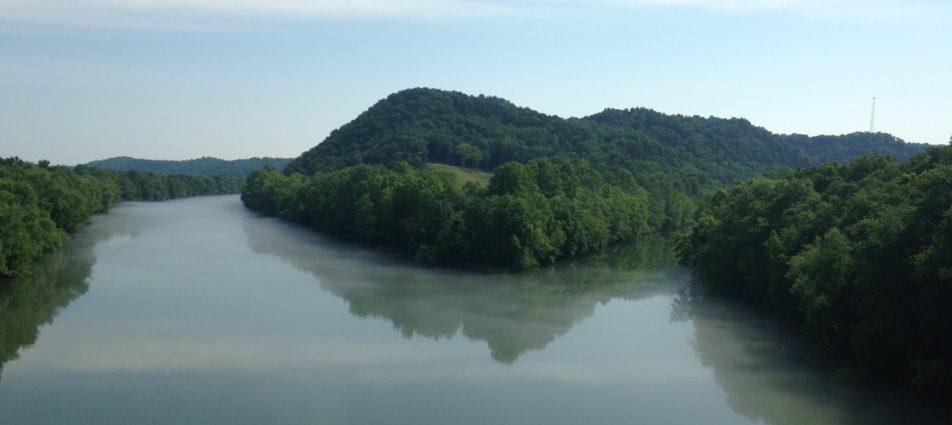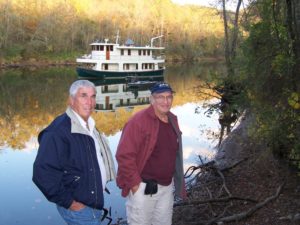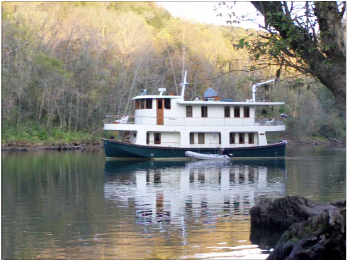Cumberland River

The Cumberland and Obey rivers converge at the western border of Celina, once a major river port. Many goods were taken downstream to Nashville on the Cumberland from Celina and points north.
About the Cumberland River…
During the early colonial period, the river was known as “Warioto” to the local Native Americans. It was called “Shauvanon” by French traders, and was also known as the “Shawnee” or “Shawonoe” before being known by its current name.
The Cumberland’s first importance was as a passage for hunters and settlers. It later supported riverboat trade, reaching to the Ohio and Mississippi rivers. Villages, towns and cities were located at landing points along its banks. Through the middle of the 19th century, settlers depended on rivers for trading and travel.
In 1750, Dr. Thomas Walker led a party of hunters across the Appalachian Mountains from Virginia, mapped and named the river for Prince William, Duke of Cumberland.
The town of Celina was once located on the banks of the Cumberland River, where the Obey flows into it. Due to frequent flooding, “town” was moved to its current location around the courthouse square. Since the building of Dale Hollow Dam, flooding is a rare issue. In May 2010, due to extensive rains, the Cumberland River overflowed its banks and flooded many areas, including Nashville. Celina saw some flooding at that time and a few others after the dam was built.
Alabama adventurers follow rivers to Celina
by BOB WEAVER – HORIZON Staff Writer
Captain Ron Beberniss and pilot Ron Cowan arrived here November 2011, aboard a 53-foot, trawler-style, hand-built, wooden boat named Annie.

After beginning near Florence, AL 16 days earlier, the pair traveled down the Tennessee and up the Cumberland rivers. They anchored in the Obey here at Donaldson Park’s boat ramp.
Beberniss and Cowan walked to the Celina square, where local antique shop owner Johnny ‘Booger’ McLerran alerted the HORIZON.
After being interviewed at the newspaper’s office, the ‘rivermen’ were given a ride back to their vessel, where they treated onlookers with tunes from a calliope installed on the top deck.
Click this picture, so you can view movie and hear the boat’s calliope music.
The Voyage
The trip covered approximately 500 miles, included a three-night stop in Nashville where the men’s wives met them to enjoy the Grand Ol’ Opry, and featured an overnight at Granville to experience the Saturday night bluegrass music at the Sutton General Store.
Gainesboro was the next stop on Sunday. The two men climbed muddy banks and walked to the square, where they enjoyed the unique atmosphere.
“No matter which way we went around that square it was an uphill trip,” Cowan said with humor. “We thought that was interesting.”
A broken bracket on one of the twin diesels that power the boat caused them to anchor for the night just above the mouth of the Roaring river.
So, the next morning, Beberniss removed the bracket and climbed the bank to the Neilson factory, where shop personnel welded the broken part. As a result, Annie and her crew continued the journey up river to their final destination here.
The Boat
Beberniss, with help and support from his wife Carol, built the wooden-hull craft over a period of 16 years, while living near Houston, TX and practicing medicine as an emergency care physician.
He built the hull and decks, and furniture and trimmings, turning every screw and even planing boards himself.
After launching the boat from League City, TX, a trip along the coast of the Gulf of Mexico, into Mobile Bay, and up the Tennessee-Tombigbee Waterway led to Florence, where Ron and Carol now make their home.
Cowan and his wife reside in Athens, AL and are frequent travel companions of the Bebernisses. Living close together, both men use Florence as a base to explore the rivers of the eastern United States.
Pictures of the interior of the boat can be seen by clicking here.
(Photos by JAYS PHOTOS, Jay Martin January 1, 2008 with Olympus 770SW Camera)

